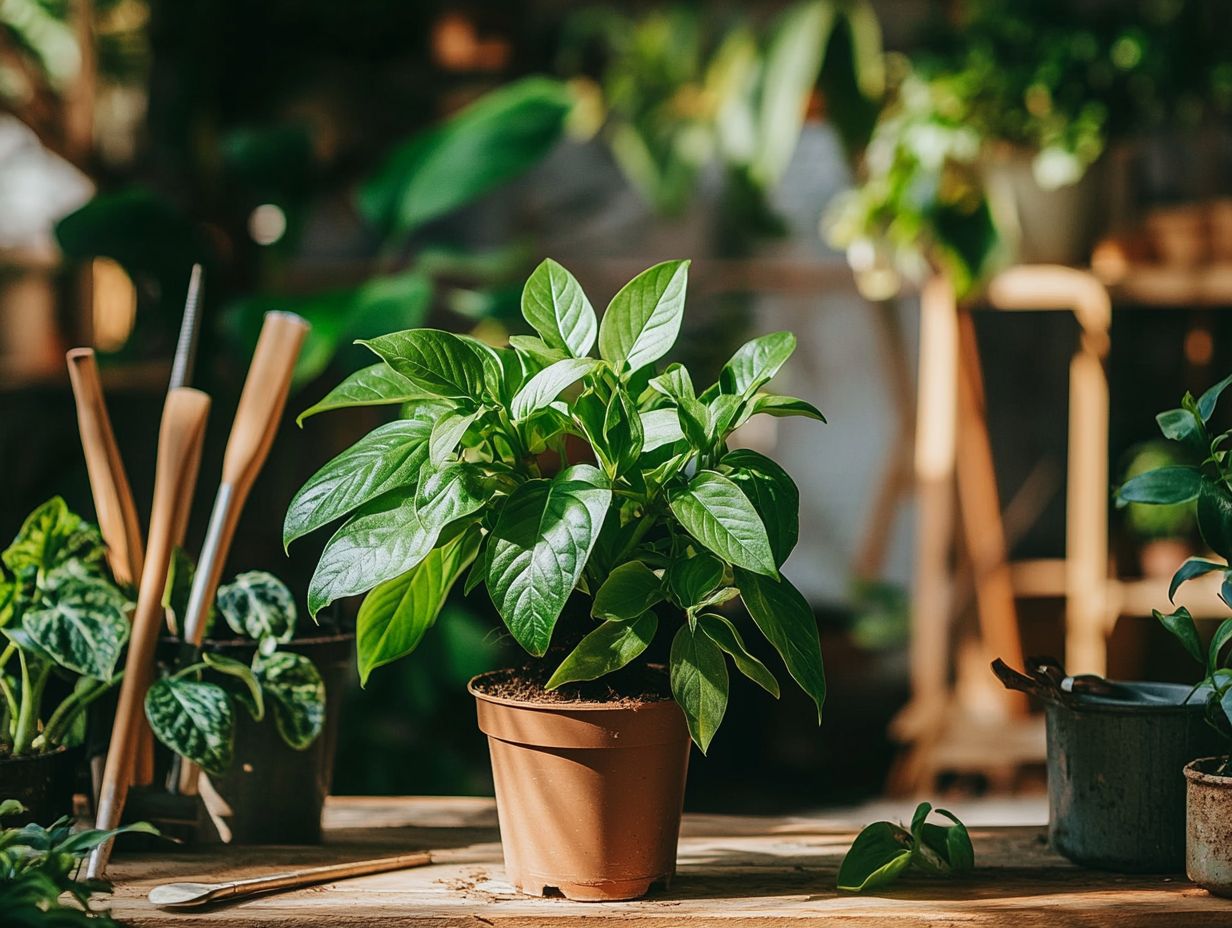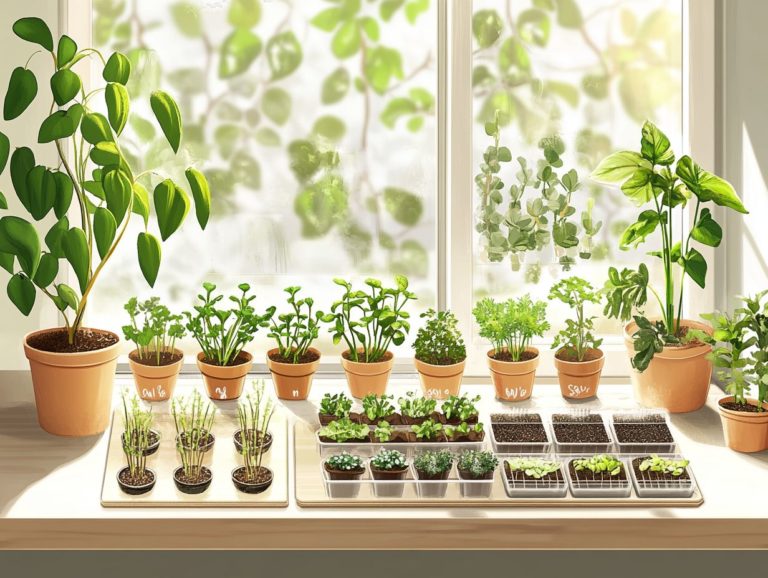How to Identify When to Propagate Your Plants
Are you ready to elevate your indoor garden or propagate your beloved outdoor plants? Mastering the art of plant propagation can unlock a realm of possibilities for any plant enthusiast.
Get ready to dive into the ultimate guide that will transform your plant propagation game! This article begins with an exploration of what propagation techniques are and why they hold significance. You ll learn how to pinpoint the ideal timing and recognize the signs that indicate it s time to propagate.
You ll delve into various methods and uncover invaluable tips to ensure your success. Whether you re a seasoned gardener or just embarking on this green journey, this guide will arm you with the knowledge you need to flourish in your plant propagation endeavors.
Contents
- Key Takeaways:
- Understanding Plant Propagation
- Signs that Your Plant is Ready to be Propagated
- Methods of Propagation
- Choosing the Right Time for Propagation
- Tips for Successful Propagation
- Frequently Asked Questions
- 1. When is the best time to propagate my plants?
- 2. How do I know if my plant is ready to be propagated?
- 3. Can all plants be propagated at the same time?
- 4. What is the difference between vegetative and seed propagation?
- 5. How can I tell if my plant is ready to be propagated by cuttings? Are there specific signs for different plant species?
- 6. Are there any tools I need to identify when to propagate my plants? What DIY propagation techniques can simplify the process?
Key Takeaways:

- Observe visual cues such as strong root growth and overcrowding to determine when your mature plants are ready for propagation.
- Consider factors like the plant’s growth cycle and current health to determine the best time for propagation.
- Follow best practices, such as using sterile tools and providing proper care, to increase the success rate of your plant propagation.
Understanding Plant Propagation
Understanding plant propagation is essential for every plant parent. It involves a range of propagation methods that facilitate the reproduction of houseplants through approaches like stem cutting, leaf cuttings, and division.
The satisfaction of nurturing new roots and witnessing their growth fosters a profound emotional connection with your plant species. Whether you re tending to beloved varieties such as Monstera Albo or ZZ plant, each method enhances your gardening experience.
In this section, you will explore the definition and purpose of plant propagation. Discover its significance in the realm of plant care, plant maintenance, and enhancing your overall growth experience.
Definition and Purpose
Plant propagation is your gateway to creating new plants from the ones you already cherish. Techniques like cutting (taking a part of a plant to grow a new one), layering, or division ensure their successful growth and foster a deeper plant connection.
Each method has its unique flair and benefits, especially for fostering strong root development. For instance, when you take cuttings, you re essentially crafting clones of your favorite plants, guaranteeing identical traits and a quicker transition to fresh soil.
Layering offers a different approach, encouraging natural rooting while keeping the parent plant stable. This method is perfect for expanding your collection without causing a fuss. Division is particularly advantageous for perennials; it refreshes crowded plants and promotes healthier root systems.
Together, these techniques do more than just produce new plant life; they elevate your overall plant care game by nurturing resilience and adaptability.
Signs that Your Plant is Ready to be Propagated
Recognizing the signs that your plant is ready for propagation is essential for achieving success in your plant care journey. Pay close attention to visual cues, such as mature plants showcasing healthy roots or indicators of overgrowth.
These signals will guide you in determining the perfect moment to propagate, ensuring your efforts yield thriving new plants.
Visual Cues to Look Out For

Visual cues such as vigorous growth, root nodes, and overgrown stems can be clear indicators that your plant is ready for propagation.
For instance, a pothos with its lush, trailing vines is a telltale sign that conditions are just right for a cutting. The plump leaves of a succulent might suggest it’s time to dive into leaf propagation.
When you spot new root nodes emerging from a healthy mother plant, it s a clear signal that division is in order. Each species has its own unique signs; rosemary, with its silvery-green foliage, often experiences growth spurts that hint at its readiness.
Conversely, plants like spiderwort may show crowded growth, indicating they could use a little room to breathe. By recognizing these various indicators across different species, you boost your chances of successful propagation and enrich your overall gardening experience.
Now that you know the signs, it s time to get started on your propagation journey!
Methods of Propagation
You have a variety of propagation methods at your disposal, such as cutting, layering, and division. Each technique presents its own unique advantages, tailored to suit different plant types and their specific adaptation needs.
This allows you to choose the most effective approach for nurturing your plants, utilizing resources like propagation stations and enhancing their growth potential.
Cutting, Layering, and Division
Cutting, layering, and division are propagation techniques that can lead to successful root growth when executed with precision. It’s essential to factor in elements like water changes and suitable containers.
By grasping the unique characteristics of each method, you can significantly enhance the chances of nurturing thriving plants. For instance, when taking cuttings whether from a stem or leaf it’s essential to use clean, sharp tools to avoid damage and disease.
Layering offers a different approach. By gently bending a low branch into the soil, you encourage natural root development, making it an ideal choice for those who prefer not to sever the original plant.
Division involves carefully separating established clumps during their dormant phase. Ensure that each new segment possesses ample roots and foliage. To further support healthy growth, be mindful of using soil for plant propagation, maintaining appropriate moisture levels, and providing adequate light.
These thoughtful practices help prevent overwhelming conditions that could lead to root rot, which is a condition where roots decay due to excess moisture. This ensures your propagation efforts yield productive and fulfilling results.
Choosing the Right Time for Propagation
Selecting the optimal time for propagation is crucial, as it can profoundly influence the success of your propagation journey.
Your decision will be shaped by various factors, including seasonal changes, different plant varieties, and prevailing environmental conditions.
Factors to Consider

When considering the perfect moment for propagation, a few key factors come into play such as your plant’s growth stage and the availability of indirect light.
Understanding your plant’s growth phase is essential; some plants thrive during their active growth seasons, making it an ideal time for cuttings. For more information on when to take cuttings, check out the best time to propagate your indoor plants. Providing bright, indirect sunlight enhances the chances of robust root development since direct sunlight can be far too intense for newly propagated plants.
Choosing the right pot, one with excellent drainage, is equally important. This helps maintain the optimal moisture level necessary for healthy roots. By paying close attention to these details, you can create the perfect environment for propagation. Understanding the life cycle of propagated plants ensures that your green companions not only survive but truly flourish.
Tips for Successful Propagation
Want your plants to thrive? Follow these essential tips! To achieve successful propagation, embrace best practices and steer clear of common pitfalls. This ensures that your houseplants flourish through careful attention and a keen awareness of the unique challenges that come with propagation.
Best Practices and Common Mistakes to Avoid
Implementing best practices in propagation, such as mastering proper watering techniques and learning from seasoned plant experts, can significantly boost your chances of success. Avoiding common mistakes will help you prevent issues like root rot.
By attentively observing moisture levels, you can determine the perfect moment to water. Ensure that the soil is just right not too dry and not overly saturated. It’s wise to choose a well-draining medium to foster healthy root development.
Understanding the unique needs of different plant species allows you to provide tailored care, which can greatly enhance your propagation results. Seeking expert advice can also prove invaluable, as it helps you identify potential pitfalls early and cultivates a deeper appreciation for the intricate nuances of plant care.
Frequently Asked Questions
1. When is the best time to propagate my plants?

Get ready to see your garden flourish! The best time to propagate your plants is during their active growing season, typically in the spring or early summer. This is when they have the most energy and are more likely to root and grow successfully.
Using gardening advice and online courses can help you time your efforts perfectly.
2. How do I know if my plant is ready to be propagated?
Look for signs that your plant is ready for propagation, such as overgrown roots, a crowded pot, wilting or yellowing leaves, or a plant that has become too large for its current space.
These are all indications that your plant needs a little help!
3. Can all plants be propagated at the same time?
No. Different plants have different optimal times for propagation. Some plants, like succulents, can be propagated year-round, while others, such as African violets, may only be successful during certain seasons.
Research your plant’s specific needs before propagating.
4. What is the difference between vegetative and seed propagation?
Vegetative propagation involves using cuttings from a parent plant to create new, genetically identical plants. Seed propagation, however, relies on planting seeds that grow into unique new plants with distinct characteristics.
Both techniques have their unique advantages and can contribute to your overall propagation success.
5. How can I tell if my plant is ready to be propagated by cuttings? Are there specific signs for different plant species?
Look for nodes, which are small bumps on the stem where new growth can occur. These are the best spots for taking cuttings. Additionally, ensure your plant is healthy and free from any diseases before propagating.
6. Are there any tools I need to identify when to propagate my plants? What DIY propagation techniques can simplify the process?
A magnifying glass can help identify nodes and readiness signs for propagation. A sharp and clean cutting tool makes the process easier and more successful.






